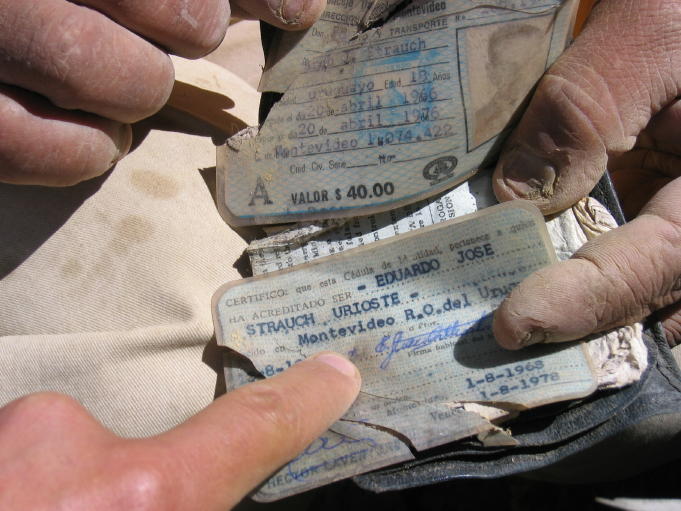The Very Lost Wallet

On February 12, 2005, a man from Colorado named Ricardo Peña found someone else’s wallet.
Normally, that wouldn’t be a noteworthy event. The wallet contained 1,000 Uruguayan pesos, thirteen American dollars, a baggage claim ticket, and a receipt for a jacket purchased on October 7, 1972 — and the photo ID of someone named Eduardo Jose Strauch Urioste, as seen above. Again, nothing really notable. The question: would he try to find the wallet’s true owner?
The answer: it’s complicated. Peña didn’t find the wallet on a street corner or a cafe. He found it in the Argentinian Andes — and it had been there a long, long time.
On October 13, 1972, pilot error caused Uruguayan Air Force Flight 571 to crash into the Andes mountains. Of the 45 people on board, 18 died in the crash or shortly thereafter. The other 27 were missing and presumed dead; early rescue attempts yielded no results and were called off shortly thereafter. The survivors set up a camp but an avalanche took the lives of eight more people about two weeks later. As food and heat sources were running out, the prospects for the other 19 were grim. They did whatever they could to survive, including resorting to cannibalism, and some managed to last for more than two months. Ultimately, the miraculous happened — a few of the survivors went out to find help and succeeded in doing so. On December 23, 1972 — 72 days after the crash — sixteen people were rescued. Their tale was recounted in the best-selling book “Alive: The Story of the Andes Survivors” in 1974, which was adapted into a movie in 1993.
That crash is why Peña was the Andes that day, more than thirty years later. An avid mountaineer and a fan of the Alive story, he hired a guide to take him to the general vicinity of the crash site. As he recounted in a later essay, he had “always been fascinated by the story” and when he learned “there was a way to reach the place where this event took place,” he extended his vacation to make the trip.
He came across what, at first, he thought were human remains, marked by a blue garment which had no reason to be there otherwise. Upon closer inspection, the garment turned out to be a coat, and there were no bones inside — but there was a wallet. Peña immediately realized that he had discovered a piece of history — the coat, given the receipt, was purchased just a week before the crash. It almost certainly belonged to one of the 45 people aboard that plane. And he was about to discover something else: The wallet’s owner was one of the survivors, and he was still alive more than three decades later.
Peña contacted Strauch and ensured that the wallet was returned to him. Strauch was grateful; he’d tell the press that the rediscovered wallet “reminds me of some happy moments we had up there on the mountain, spiritual moments as well as all the suffering and pain we went through.” And perhaps more importantly, the wallet created a new set of friends. Strauch and Peña decided to go into business together; the two now run tourist expeditions of the Andes, highlighting the trials and trails of the crash survivors.
Bonus fact: The Andes mountains reach heights of 22,838 feet above sea level, which makes them an odd place to find fossils of whales. But in 1987, that’s exactly what was discovered there. The New York Times (at that link) explains: “When these animals died from 15 million to 20 million years ago, their carcasses settled to the ocean floor and were embedded in submarine sediments. But since then, the violent upthrusting of the Andean chain has carried the sediments to the tops of mountains.”
From the Archives: How a Unit Conversion Error Turned an Airplane into a Glider: A landing which should have been a crash landing, except for some very good piloting (but caused by some very bad math).
Related: “Alive: The Story of the Andes Survivors” and the movie adaptation.
